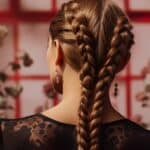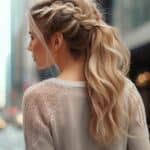Hair is a defining feature for many individuals and plays a significant role in one’s appearance. With various hair types, textures, and conditions, it can be overwhelming to figure out the best hair care and styling practices for your unique situation. This article aims to provide valuable hair advice, including understanding different hair types, establishing a proper hair care routine, and exploring various styling tips and tricks.
It’s essential to recognize that what works for one person may not be suitable for another. Therefore, it is crucial to identify your hair type and choose appropriate products and treatments to maintain healthy and beautiful locks. Consulting with a professional hairstylist may offer invaluable customized advice you won’t find in generic tutorials or articles.
Don’t forget that maintenance is just as important as styling. Preventing and treating hair damage is a critical part of the hair care journey, and it involves not only external practices but also internal factors, such as nutrition and overall health. Learning from common hair mistakes and debunking hair myths can save you from unnecessary frustration and disappointment.

Key Takeaways
- Understanding your hair type is essential to choosing suitable products and treatments.
- Consulting with professionals can provide personalized hair care advice.
- Preventing and treating hair damage is a crucial part of maintaining healthy hair.
Understanding Hair Types
When it comes to hair care, it’s essential to understand the different hair types to determine the best routine and products for your specific needs. By knowing the characteristics of your hair, you can ensure it remains healthy and manageable.
Hair type can be categorized according to its curl pattern and texture, among other factors. There are four main hair types: straight (type 1), wavy (type 2), curly (type 3), and coily (type 4). These classifications can further be broken down into subcategories: type 1A (fine and very straight), 2B (medium and clearly wavy), and so on.
Straight hair (type 1) is typically fine and smooth, with no visible curl or wave. This hair type may be prone to oiliness due to the ease of natural oils traveling down the hair shaft. Maintaining cleanliness and avoiding buildup is essential for straight-haired individuals.
Wavy hair (type 2) features a slight curl that forms an ‘S’ shape. The natural wave can vary from loose and beachy (type 2A) to pronounced and more defined (type 2C). Wavy hair often needs moisture and light styling products to enhance its texture and combat frizz.
Curly hair (type 3) has a spiral or ringlet shape. Type 3A hair has loose, large curls, while type 3C features tighter, corkscrew curls. This hair type tends to experience more dryness and frizz, making it crucial to use moisturizing and conditioning products.
Coily hair (type 4) is the most densely curled, ranging from tight zigzags (type 4A) to densely packed coils (type 4C). Coily hair may be prone to dryness, breakage, and shrinkage, so hydration and gentle styling techniques are key.
Within these categories, hair also varies according to texture, which can be fine, medium, or coarse. For example:
- Fine hair has a small diameter and may appear thinner. It can struggle to hold styles and become easily weighed down by heavy products.
- Medium hair is the most common texture and has a moderate thickness, holding styles reasonably well without being too quickly weighed down by products.
- Coarse hair has the largest diameter, making it strong and durable. However, it can be more resistant to styling and prone to frizz.
Other factors, such as dry hair, wet hair, or external conditions, may also affect how hair behaves. Ultimately, understanding your hair type and the specific requirements it has will support you in finding the most fitting hair care solutions.
Hair Care Basics
Achieving healthy and beautiful hair starts with understanding the basics of hair care. This section will provide an overview of essential hair care steps, incorporating concepts such as conditioning, oil application, shampooing, and maintaining a balance of natural sebum production.
One of the fundamental aspects of hair care is regular cleansing. Choose a shampoo that suits your hair type, whether dry, oily, or normal. Concentrate the shampoo primarily on the scalp, as this helps to avoid stripping the entire hair length of its natural oils. Shampooing the scalp encourages the balance of sebum production, vital for maintaining hair health.
A conditioner after shampooing can keep the hair moisturized, smooth, and manageable. A conditioner is particularly beneficial for combating frizz and preventing breakage. Select a conditioner that complements your hair type, focusing on applying it primarily to the mid-lengths and ends of the hair to prevent product buildup on the scalp.
Natural oils such as coconut, argan, or jojoba oil can help maintain a healthy moisture balance and promote hair growth. Depending on your hair type, the frequency of oil application may vary. For instance, those with dry hair may benefit from applying oil more frequently, while those with oily hair types should be cautious not to overuse oils.
Incorporating regular brushing into your hair care routine is essential for distributing natural oils evenly along the hair shaft and detangling and removing any loose hair. Choose a brush with gentle bristles that glide effortlessly through your hair, and avoid brushing wet hair, as it can be more prone to breakage.
By following these fundamental hair care practices, you’ll be on your way to achieving healthy, manageable, and beautiful hair. Remember, the key to successful hair care is consistency and adapting your routine to meet the unique needs of your hair type.
Effective Hair Treatments
There are various hair treatments available that can help maintain and improve the health of your hair. Treatment choice depends on your hair type, texture, and needs. This section will discuss some effective hair treatments that can cater to different hair concerns.
Conditioning is a crucial step in maintaining hair’s health and appearance. A deep conditioner can provide extra care, especially for chemically treated or damaged hair. Deep conditioners penetrate the hair shaft and nourish it from within, helping to repair and prevent split ends and breakage. It is recommended to deep condition at least once or twice a month.
Hair oil is another treatment that can provide multiple benefits, such as nourishing, moisturizing, and strengthening your hair. There are various oils, such as coconut, argan, and jojoba. Work the oil into your scalp and hair using a small amount, leaving it in for at least 30 minutes or overnight before washing it out.
Dry shampoo is a useful product when you don’t have time for a traditional shampoo and conditioner routine. It helps to absorb excess oil and refresh your hair without requiring water. A quick application can instantly make your hair look cleaner and more voluminous.
Serum is a hair treatment that reduces frizz, adds shine, and protects your hair from environmental damage and heat styling. Apply a small amount of serum to the ends of your hair, avoiding the roots, before heat styling or for a finishing touch to your hair routine.
Massage your scalp regularly to increase blood circulation, which can lead to healthier and faster hair growth. You can use hair oil during the massage for added benefits. Spending a few minutes massaging your scalp daily can have long-term positive effects on hair health.
Incorporating these treatments into your hair care routine can lead to noticeable improvements in your hair’s health, strength, and appearance. Remember to choose treatments based on your specific hair concerns and needs for optimal results.
Styling Tips and Tricks
When it comes to achieving the perfect hairstyle, there are various factors to consider and techniques to adopt. These styling tips and tricks will cater to hair types, including straight, wavy, and frizzy.
Know Your Hair Type: The first step to styling hair is understanding its type and individual needs. Knowing your hair’s texture and personality lets you choose the right products and techniques to enhance its natural beauty.
Tools Matter: Proper styling tools are crucial to achieving a flawless look. Invest in a wide-tooth comb for seamless detangling, a dependable heat protection spray to minimize damage, and a high-quality hair dryer for efficient blow-drying.
Variety of Hairstyles: Experiment with different styles to keep things exciting and cater to your mood and occasion. For a casual chic look, try loose waves or curls. For an elegant event, an updo can add extra glamour. Don’t shy away from trying something new.
Product Use: Using the correct products can aid in achieving the desired hairstyle. For added volume and body, a lightweight mousse can do wonders. For defined curls and waves, opt for styling gels that provide long-lasting hold without leaving your hair crunchy or stiff.
Heat Protection: When using heat-styling tools, always apply a heat protection spray beforehand to prevent damage to your hair. This will keep your locks looking healthy while also prolonging your chosen style.
Blow-Drying Techniques: To avoid frizz and statically charged hair, use the blow-drying technique that best aligns with your hair type. Point the nozzle downwards for straight hair to seal the cuticle and smooth the strands. For wavy and curly hair, use a diffuser attachment to distribute heat and evenly keep your natural texture intact.
Remember, practice makes perfect. By following these styling tips and tricks, you can confidently create and maintain a variety of beautiful hairstyles while also maintaining the health and integrity of your hair.
Preventing and Treating Hair Damage
Preventing and treating hair damage is essential for your hair’s overall health and appearance. One common cause of hair damage is split ends, which occur when the hair’s outer protective layer (the cuticle) becomes damaged or frayed. Breakage can also occur from external factors such as chemicals, heat styling, or excessive tension.
Maintaining proper hair care routines is crucial to protect your hair from damage. Regularly conditioning your hair can help keep it moisturized and prevent breakage. After shampooing, apply a conditioner to help detangle and smooth the hair. Additionally, using hair oils, such as coconut or argan oil, can provide extra nourishment and protection for your tresses.
Hair loss and thinning can result from various factors, including genetic and hormonal issues. External factors, such as harsh chemicals and chlorine from swimming pools, can weaken the hair and contribute to hair loss. To combat hair loss, opt for gentle, sulfate-free shampoos and conditioners. Avoid exposure to contaminants like chlorine by wearing a swim cap or rinsing your hair thoroughly after swimming.
Detangling your hair is another critical aspect of preventing and treating hair damage. Gently detangle your hair using a wide-tooth comb, starting from the tips and working up to the roots. Avoid fine-toothed combs or brushes, as they can cause unnecessary stress on your locks and lead to breakage.
In summary, to prevent and treat hair damage, it is essential to:
- Keep your hair moisturized with regular conditioning
- Protect your hair from harmful chemicals, heat, and tension
- Address hair loss and thinning through appropriate hair care and avoidance of irritants
- Gently detangle your hair using a wide-tooth comb to minimize breakage and damage
Choosing the Right Hair Products
Selecting suitable hair products for your specific hair type is crucial to maintaining healthy and vibrant hair. With a wide range of products available, here are some key considerations for choosing the best options for your hair.
Shampoo is vital in keeping your hair clean and your scalp healthy. Look for ingredients rich in vitamins, nutrients, and minerals to stimulate your scalp and promote hair growth. Focus on shampooing the scalp primarily, as concentrating on the hair length may result in dull and coarse strands.
Conditioner should be used after every shampoo unless you use a 2-in-1 shampoo. Regular conditioning helps keep your hair moisturized, reduces breakage, and leaves it lustrous. Opt for a deep conditioner occasionally to provide extra nourishment and restore your hair’s health.
Dry shampoo is a quick refreshment for your hair when you are short on time or want to avoid frequent washing. It absorbs excess oil and adds volume to your locks.
Hair oil, serum, and mousse are excellent styling options that provide moisture, control frizz, and protect your hair from damage. Oils have nourishing properties, while serums are lightweight and create a shiny finish. Mousse helps add volume and texture to your hair.
Gels are suitable for styles that require hold and shape, as they provide firmness without making your hair feel heavy or sticky. Choose an alcohol-free gel to prevent dryness and flaking.
Heat protection spray should always be applied before using heat-styling tools such as flat irons, curling irons, or blow dryers to avoid damaging your hair. These sprays form a shield around the hair shaft to minimize heat-induced breakage.
Detangling products and tools are essential for removing knots and tangles from your hair without causing breakage. Look for detangling sprays, brushes, or combs that help you achieve tangle-free, smooth hair, regardless of your hair type.
Finally, it’s important to remember that everyone’s hair type and needs differ. It’s a good idea to experiment with a few products and pay attention to how your hair responds. With trial and error, you can find the perfect combination of hair care products for your unique hair type.
Consulting Professionals
When seeking hair advice, consulting professionals such as stylists and hairstylists can provide valuable personalized recommendations tailored to individual needs. These experts have trained in various hair techniques, trends, and treatments, enabling them to understand different hair types and preferences to offer the best solutions to their clients.
Many professional hairstylists offer one-on-one consultations through video calls, using platforms like FaceTime, WhatsApp, or Instagram, ensuring clear and convenient communication. During these sessions, the stylist must listen attentively and understand the client’s expectations, making them feel comfortable and heard.
In addition to individualized hair advice, seeking input from editors or other hair experts who contribute to blogs, magazines, or other online publications can be beneficial. These professionals usually have vast industry knowledge and can offer tips and tricks catering to various hair issues. They often share their expertise through written articles, video tutorials, or social media posts, making it easy to access their insightful feedback.
In conclusion, consulting professional hairstylists or stylists can significantly enhance one’s hair care routine by providing personalized and knowledgeable advice tailored to meet specific requirements. Additionally, seeking expert opinions through various channels enables individuals to learn hair care tips and techniques, ultimately leading to healthier, happier hair.
Common Hair Mistakes to Avoid
Taking care of your hair is essential to maintaining its health and appearance. However, people often make several common mistakes in their hair care routines. By avoiding these pitfalls, you can achieve a healthier and more attractive head of hair.
One common mistake is the over-manipulation of the hair. Excessive brushing, combing, or styling can cause breakage; split ends, and other damage. It is important to handle your hair gently, especially when wet, as it is more fragile in this state.
Regarding hair treatments, some individuals may overuse chemicals for a specific look. For instance, frequently applying highlights or attempting to achieve a fully bleached hair look can weaken your hair and make it prone to damage. It is advisable to consult with a professional before undergoing any chemical treatments, and if possible, consider alternatives like temporary hair colorants or enhancing your natural hair color without bleaching.
Another hair care error is using excessive heat on the hair. Flat irons, curling irons, and hair dryers can all inflict damage if used improperly or too frequently. Try to minimize the use of heat-styling tools and opt for air-drying or gentle heat settings when possible.
Using too much or too little product can also adversely affect hair health. Overloading your hair with styling products, like gels or hairsprays, can cause it to appear stiff and weighed down, while not using enough can lead to frizz and unmanageable locks. To combat this issue, pay attention to the instructions on your hair products and only apply the recommended amount.
Lastly, washing your hair too frequently or infrequently can be detrimental. Overwashing can strip natural oils away and cause dryness, while not washing often enough can lead to greasy hair and poor scalp health. Find the best balance for your hair type and adjust your washing routine accordingly.
By keeping these common hair mistakes in mind, you can develop a better hair care routine and enjoy healthier, more beautiful hair.
Frequently Asked Questions
What are essential hair styling tools?
There are a variety of essential hair styling tools that can help you achieve the desired look. These include a hairbrush or comb, hairdryer, straightener, and curling iron. Additionally, investing in quality hair products such as heat protectants, hair sprays, and styling creams can also be beneficial for maintaining the style and health of your hair.
How can I maintain healthy hair?
To maintain healthy hair, it is important to follow a proper hair care routine. This includes washing your hair regularly with a gentle shampoo and conditioner, applying nourishing treatments, and letting your hair dry naturally whenever possible. Regular trims or haircuts every month and a half can help keep your hair in good shape. Moreover, a balanced diet and proper hydration can contribute to overall hair health.
What are professional tips for coloring my hair?
Choose a high-quality hair dye when coloring your hair, and follow the manufacturer’s instructions carefully. This will ensure that the color lasts longer and looks vibrant. Consulting a professional hairstylist is highly recommended if you have any concerns or need assistance with the process. Additionally, use color-safe shampoos and conditioners to maintain the longevity of the color.
How can I improve my hair styling skills?
Improving your hair styling skills takes practice and patience. Experiment with different techniques, watch tutorials from reputable sources and observe how professionals style hair. Learning about your hair type and becoming familiar with the products and tools best suited to it can also help hone your skills.
What are beginner-friendly hairdressing techniques?
For beginners, several simple hairdressing techniques can be practiced, such as mastering basic braids, creating ponytails and buns, and getting comfortable with hair styling tools. As your skills progress, you can explore more intricate styles, like French braids, fishtail braids, and using hair accessories to enhance your looks.
What are effective ways to achieve beautiful hair?
Achieving beautiful hair involves a combination of proper care, styling, and healthy habits. To obtain and maintain gorgeous locks, keep your hair clean, well-conditioned, and protected from heat and other damaging factors. Additionally, experiment with different styles and techniques to find the ones that best suit your hair type and maintain a healthy lifestyle to support overall hair health.





